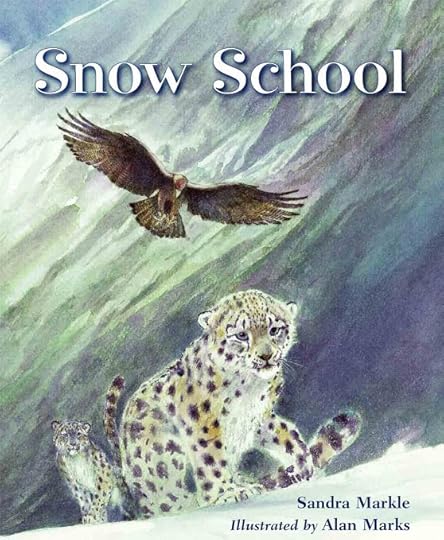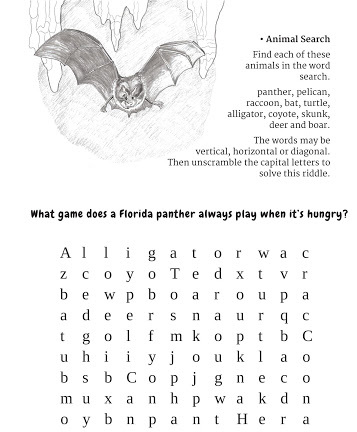Sandra Markle's Blog, page 9
January 13, 2021
CREEPY GOOD!
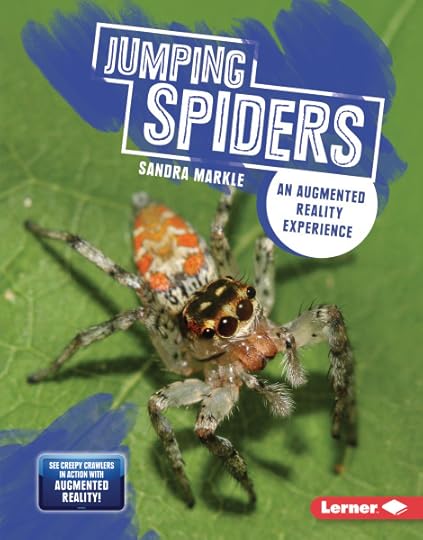
EXCITED to share! Augmented Reality lets the spiders in my Lerner Publishing book become 3-D and MOVE. Not scary--just AWESOME way for kids to learn. It's the future of Picture Books here NOW!!!!!
January 10, 2021
LETS ALL GO TO SNOW SCHOOL! I'M READING!
Ready to hear this story? Ok--sit back and enjoy!
Now, keep going to explore more and do some fun discovery activities....
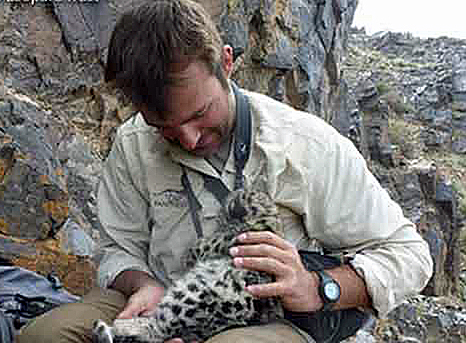 Dr. Tom McCarthy with snow leopard cub
Dr. Tom McCarthy with snow leopard cub(courtesy of Panthera Snow Leopard Trust)When I can, I love to investigate firsthand. But, when that isn't possible, I track down experts who have been able to study animals in amazing wild places. Then I can share the stories talking to those experts inspire--like Snow School . I discovered that story about snow leopard cubs growing up from interviewing Dr. Tom McCarthy who has spent many years climbing the high, rugged mountains of Pakistan in order to learn about the life and behavior of snow leopards. That's it--shown in red on this globe.

The setting for story is the Hindu Kush Mountains in that country. That high mountain habitat is one of the harshest on Earth. It requires the cats to be able to chase fast prey downhill over very rocky terrain.
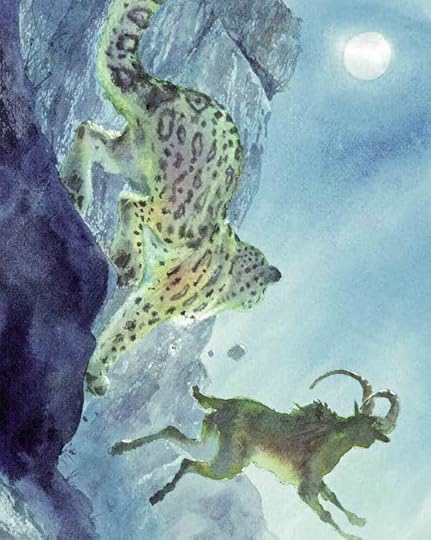
Even during his many years studying snow leopards Dr. McCarthy shared that he only had a chance to watch a few downhill chases as snow leopards caught prey. He said, “Once, I was lucky enough to see a mother have two cubs with her while she hunted.”
Dr. McCarthy guessed the cubs were in training. Snow leopard cubs spend two years with their mothers learning to survive on their own. That inspired me to wonder what lessons snow leopard cubs need to learn in order to be successful in the extreme conditions of their home habitat.
For one thing, as soon as they’re big enough, snow leopard cubs travel with their mother. That way they get a close look at the features of their environment. And they learn the shortest, safest routes to take.

The snow leopard’s habitat is really a high desert with very steep terrain. When these cats hunt, they have to chase down prey animals, like ibex, capable of running down steep, rocky slopes without falling. And they have to pounce at just the right moment to stop their prey without going over a cliff.
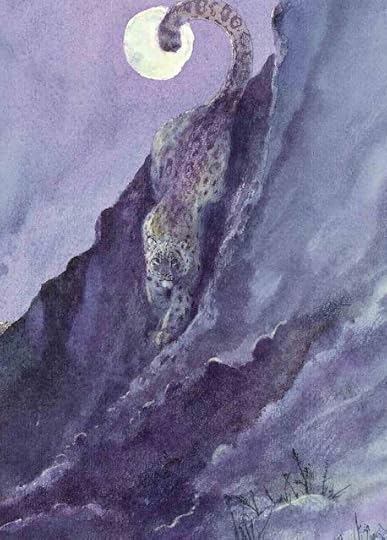
Snow leopards do have some natural built-in advantages. One is a very long tail. Dr. McCarthy reports that a snow leopard’s tail is all muscle and that it’s heavy. He said, “It must even be heavy for the snow leopard. In snow, I’d see a mark where a cat would start to drag its tail after every two or three steps. So holding up its long tail must be tiring.”
Having such a long tail is worth the effort, though, when the snow leopard starts to run. It swings its tail back and forth and that helps it stay balance while twisting and turning. To get a feel for how its tail helps a snow leopard stay balanced, try this. Stand on one foot with your hands at your sides. Then repeat standing on one foot but this time stretch out your arms and move them forward and backward.
Snow leopards also have big feet that act like snowshoes, helping them walk on top of fluffy snow. In fact, Dr. McCarthy reported a snow leopard’s feet leave very round footprints because their feet are about as wide as they are long (about four to five inches in both directions.)
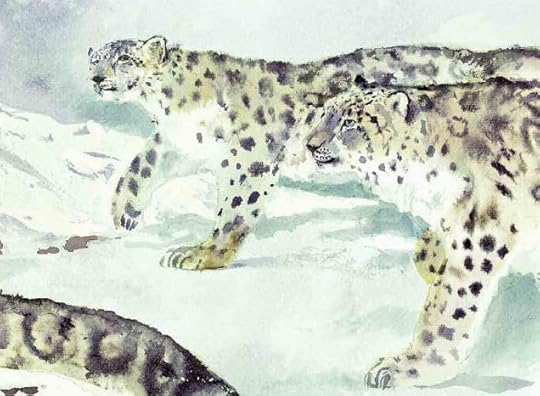
These cats also have a lot of fur around their toes and the pads of their feet to shield them from the ice and snow. Like housecats, snow leopards have retractable claws. They put these out to help them climb and to stop themselves from skidding.
Dr. McCarthy reported that once a snow leopard catches prey it needs a safe place to eat—safer than on a steep mountainside. Dr. McCarthy said, “I’ve watched a snow leopard drag a big goat that weighs as much, if not slightly more, than the cat does. And it drags this prey uphill.”
Imagine pulling something that weighs as much as you do. Now, imagine doing it the way a snow leopard does. This cat bites to grab its prey. Then it drags this weight between its legs. This is another behavior snow leopard cubs learn by being copycats, doing what their mother does.
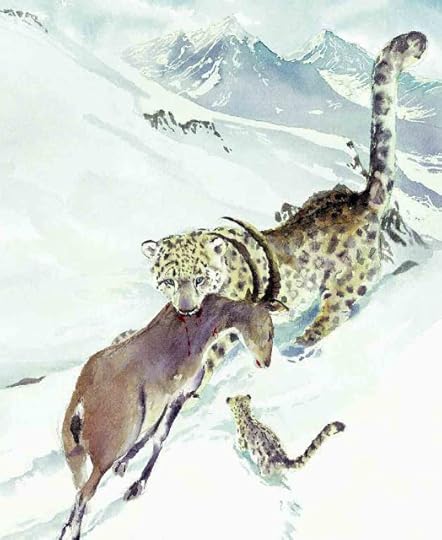
You might be surprised to learn that snow leopards usually only get a chance to catch big prey about once a week. So when it does, the cat is likely to stay by its prey and eat as much as 25 pounds of meat a day for two to three days.
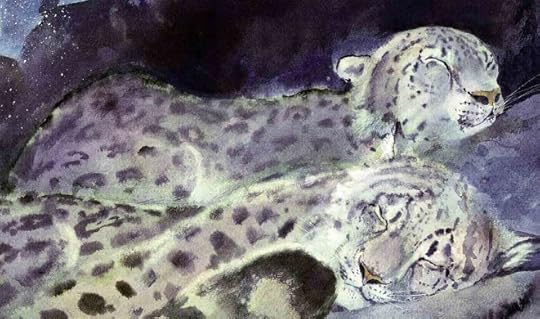
Can you guess what snow leopards do after such big meals? You’re right! They sleep. Like lions, tigers, and housecats, snow leopards sleep most of the day to save their energy for hunting.
January 6, 2021
January 4, 2021
I'M READING GASPARILLA'S GOLD--DON'T MISS IT!
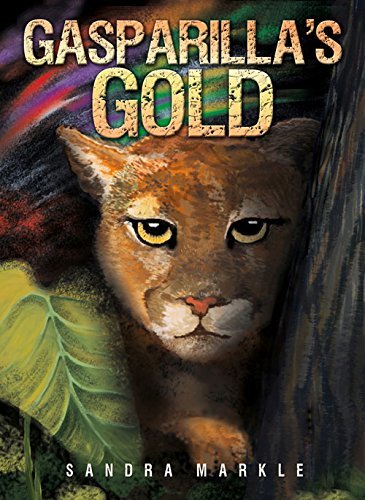
Ready for FUN!? Then click AMAZON to share my Middle Grade novel now available on Amazon Kindle as well as in print. In fact, it's FREE on KindleUnlimited and super inexpensive to own. I've even made it available to enjoy and then loan.
But first, I want to personally share a sample. So I'm reading the first two chapters aloud. I had fun launching back into the action and the characters. I hope you enjoy it!
For more FUN...Enjoy this Animal Search featuring all the animals you'll find in GASPARILLA'S GOLD.
December 18, 2020
12 ARACHNIDS of CHRISTMAS!

It just wouldn't be the holiday without my sharing The TWELVE ARACHNIDS OF CHRISTMAS! And for any of you who are discovering this for the first time, ENJOY!
[Books mentioned below are from my ARACHNID WORLD Series by Lerner]
 And once you check this out, create your own WILD take on the 12 Days of Christmas!
And once you check this out, create your own WILD take on the 12 Days of Christmas!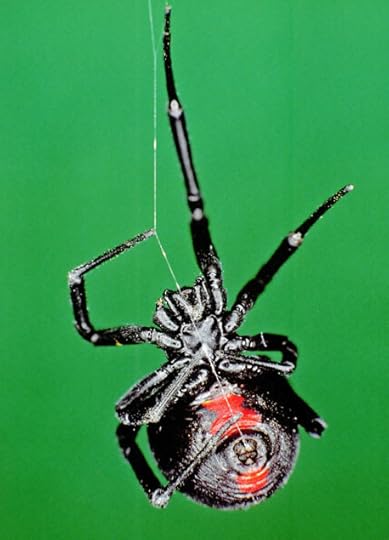
On the first day of Christmas, my true love gave to me... a black widow in a fir tree.
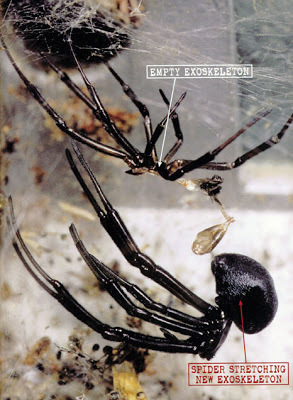
As I watched, that black widow spider dangled upside down from a silk thread. Next, its exoskeleton (armor-like covering) split open along the back. Then the spider pushed and pulled and crawled out of its exoskeleton.
What in the world just happened? To find out, read Black Widows: Deadly Biters pages 22 through 23.
*Or check the answers from Spider Clause at the very end.
On the second day of Christmas, my true love gave to me two striped bark scorpions--one big female 3 inches (7.5 cm) long and a smaller male.

As I watched, the male grabbed the female's pedipalps (body parts near the mouth). He tugged her forward and then they turned around in a circle. They did this over and over for hours.
What was happening to my scorpions? To find out, read Scorpions: Armored Stingers pages 28 and 29.
*Or check the answers from Spider Clause at the very end.
On the third day of Christmas, my true love gave to me three female Carolina wolf spiders.

As I watched, a round ball about one-third as big as the spider and stuck to its spinnerets split open. Hundreds of tiny spiders crawled out and climbed onto the big spider.
What's likely to happen next? To find out, read Wolf Spiders: Mothers On Guard pages 26 through 29.
*Or check the answers from Spider Clause at the very end.
On the fourth day of Christmas, my true love gave to me four wind scorpions.
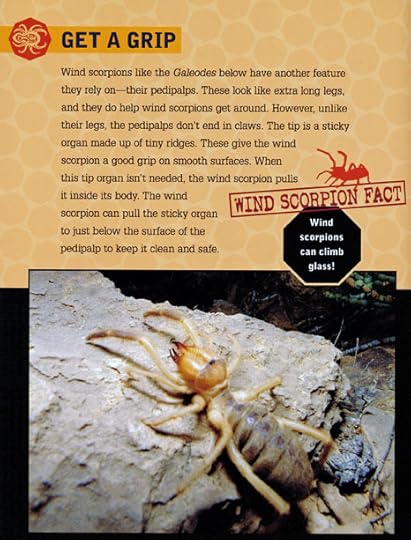
Almost at once, one of the wind scorpions ran straight up a nearly vertical rock. How did it keep from falling off? To find out, read Wind Scorpions: Killer Jaws pages 24 and 25.
*Or check the answers from Spider Clause at the very end.
On the fifth day of Christmas, my true love gave to me five tarantulas.
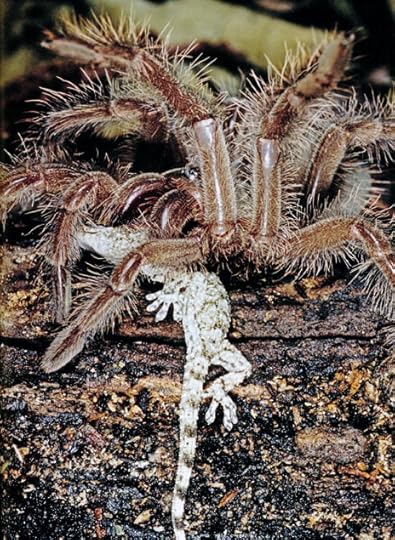
One goliath bird-eater tarantula was holding a gecko. As I watched it sank in its fangs and brought up digestive juices.
Why in the world did it do that? To find out read Tarantulas: Supersized Predators pages 32 and 33. *Or check the answers from Spider Clause at the very end.
On the sixth day of Christmas, my true love to me six female orb web weaver spiders spinning their webs.
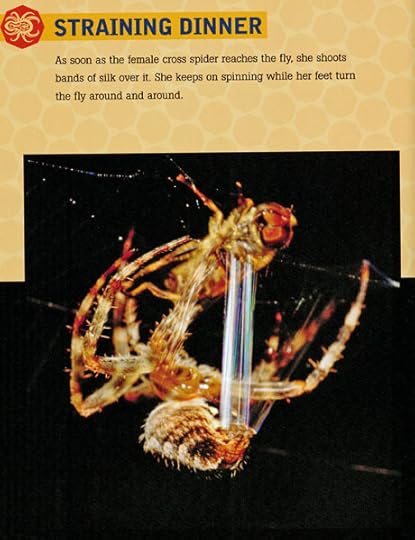
As I watched, a fly landed on one spider's web. That female ran to the fly and shots strands of silk over it.

On the seventh day of Christmas, my true love gave to me seven fishing spiders fishing in a pond.

At just that moment, a bat flew past and all the fishing spiders dived beneath the surface. They stayed underwater for nearly thirty minutes.
How were they able to stay underwater for so long? To find out, read Fishing Spiders: Water Ninjas pages 22 through 23. *Or check the answers from Spider Clause at the very end.
On the eighth day of Christmas, my true love gave to me eight crab spiderslurking inside flowers.
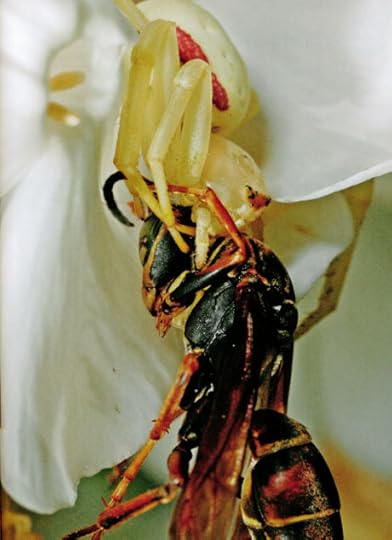
Some goldenrod crab spiders were inside yellow flowers and they were yellow. Other goldenrod crab spiders were inside white flowers and they were white.
How were these spiders able to be just the right flower color to hide and wait to ambush insects? To find out, read Crab Spiders: Phantom Hunters pages 22 and 23. *Or check the answers from Spider Clause at the very end.
On the ninth day of Christmas, my true love gave to me nine harvestmen packed close together and bobbing up and down.

Why were they doing that? To find out, read Harvestmen: Secret Operatives page 21. *Or check the answers from Spider Clause at the very end.
On the tenth day of Christmas, my true love gave to me ten ticks-a-sucking blood from their host.
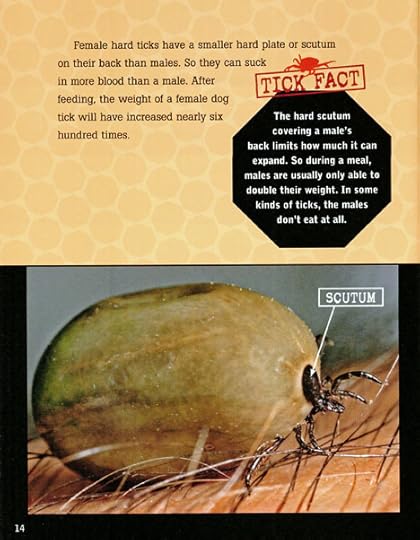
As I watched these female dog ticks over several days, their bodies swelled up until they were nearly six hundred times bigger.
How in the world could they swell so big? To find out read Ticks: Dangerous Hitchhikers pages 14 and 15. *Or check the answers from Spider Clause at the very end.
On the eleventh day of Christmas, my true love gave to me eleven jumping spiders jumping.
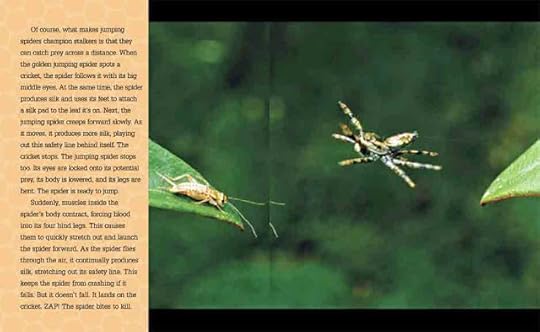
As I
How could it possibly jump so far? To find out, read Jumping Spiders: Gold Medal Stalkers pages 22 and 23. *Or check the answers from Spider Clause at the very end.
On the twelfth day of Christmas, my true love gave to me twelve mites-a-multiplyingon a bean plant.

At first, I couldn't see the tiny two-spotted mites sucking on one of the plant's leaves. In less than a month, the plant was nearly covered with web strands dotted with tiny mites. They were sucking the plant's juices and producing even more two-spotted mites.
How did there get to be so many so quickly. To find out, read Mites: Master Sneaks pages 36 and 37. *Or check the answers from Spider Clause at the very end.
Yes, my arachnid Christmas this year is one I'll always remember. After all, it's the year I received:
12 mites-a-multiplying11 jumping spiders jumping10 ticks-a-sucking9 harvestmen bobbing8 crab spiders lurking7 fishing spiders fishing6 orb weavers spinning5 tarantulas4 wind scorpions3 wolf spiders2 scorpionsAnd a black widow in a fir tree
And as he drove out of sight, Spider Claus called, "Merry Christmas to all and a MUCH Happier New Year!"

ANSWERS1 Black Widow--This spider was bigger. Because it's skeleton is an exoskeleton (on the outside), it had to shed this. The new exoskeleton quickly hardened.2 Scorpions--The pair is courting and preparing to mate and produced baby scorpions.3 Wolf Spider--The baby spiders climb onto their mother's back and ride along for a week or two. That way they stay safe from predators while they live off their stored yolk and keep growing bigger. 4 Wind Scorpion--It has pedipalps--that look like long legs--with a sticky tip to grip and hang on.5 Tarantula--To turn its prey into a liquid it can suck in. Get out of the way, those hairs can irritate your skin.6 Orb Weavers--This keeps the prey from escaping. The strands don't break because they're tougher than Kevlar, the fabric used to make bulletproof vests.7 Fishing Spiders--Air is trapped between its body hairs. The spider breathes by drawing oxygen into its book lungs from this air-filled coat.8 Crab Spiders--These spiders can change color enough to match where they hide.9 Harvestmen--Packed close together and bobbing makes them look like a much bigger animal so predators leave them alone.10 Ticks--Like a fan opening, the lower part of its body can spread apart and expand as it sucks in a blood meal. That bite can pass on a disease, like Lyme disease.11Jumping Spiders--It jumps when muscles inside its body contracts, forcing blood into its four hind legs. These stretch out and launch the spider. A jumping spider can jump two to three times its body length. That's amazing--if you don't think so, see how far you can jump.12 Mites--A few become many quickly because mites go from egg to adult ready to lay eggs in less than a month.
November 21, 2020
STEMgineer HOME for the HOLIDAYS!

This year decorating for the holidays--whatever holidays you celebrate--it's entirely up to you, the STEMgineers.
So POWER UP!

STEMgineers, be as wild as you can. Start by STEMgineering how you would make the outside of your home totally MAGIC! Photograph or Draw it. Then Animate it. Model it. Build it. Or code and computer program it.
Here are some ideas to get
you started.

You'll need lights, of course.

The more sparkle, twinkle, flash and strobe you have the merrier.


What will you do?
And there should be some action too.

Could be a snow machine to produce a hill for sledding. Could be a water park, twisting, turning water shoots from your apartment down to the playground.
 Or a water playground that's heated and just looks cool.
Or a water playground that's heated and just looks cool.

Or, perhaps your whole yard--and a bit more--becomes a snow maze.

If you live where winters are warm, imagine, instead, you're creating a sand maze.

Don't forget to include treats! Your favorites, naturally. But give this a STEMgineering touch too.

You could spin around and around in a giant cotton candy machine to get coated in the treat that you eat.

Or imagine an ice cream sundae machine. Name the ingredients you'll add. Then describe in detail the giant, delicious, delightful sundaes it creates.

If you prefer, healthier snacks such as carrots, cheese, and celery, imagine instead a machine that turns them yummy and toasty.
Ready! Set! Go!
It's time for you to get started!!!

Whatever you STEMgineer for your spin on your home for the holidays it should be created from the wildest ideas you can imagine.
Now, GET STARTED!
November 19, 2020
SPIDER FUN!Can You Solve The Mysteries?The spiders belo...
SPIDER FUN!

Can You Solve The Mysteries?
The spiders below have been divided into 2 groups--those that alike and those that are different. What makes the spiders in Group 1 alike? What makes them different from Group 2?
 Group 1
Group 1
 Group 1
Group 1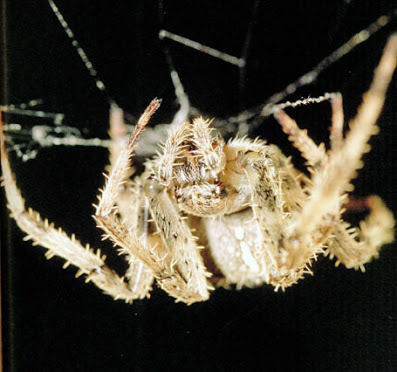 Group 2
Group 2
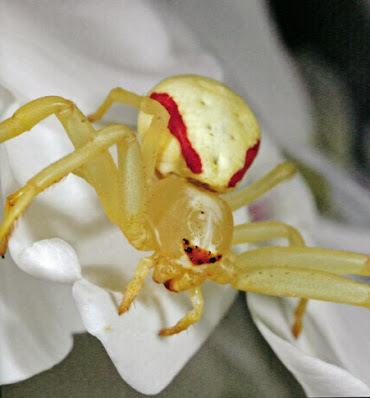 Group 2
Group 2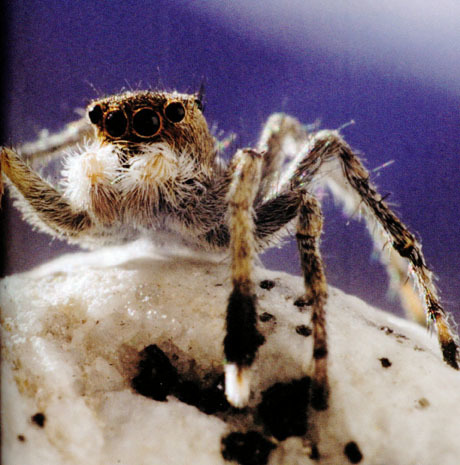
Did you guess that the spiders in Group 1 share having two middle front eyes that are bigger than their other eyes?
Now brainstorm at least three other features you could use to regroup the spiders into groups: those that share the feature and those that don't.
Here are two possibilities to get your creative juices flowing:
Group 1: Those that are light colored; Group 2: Those that aren't. Group 1: Those that look hairy; Group 2: Those that don't.
Can you do this!?
Eat Like A Tarantula

Some spiders, like tarantulas, are able to crush and partly break up the prey they catch. However even the biggest tarantulas can't chew and swallow chunks of food. They bring up digestive juices that break down their food into a gooey liquid. Then suck it in.
To sample eating like a tarantula work with an adult partner and follow these steps:
1. Start with one ready-to-eat mini-cup of fruit-flavored Jell-O.

2. Scoop the Jell-O into a cup. Mash it with a spoon or fork. Now, it's broken up like a tarantula's buggy meal.
3. Pour in apple juice to cover the Jell-O. The apple juice will act like digestive juice the tarantula brings up.
4. When the Jell-O is a gooey liquid, use a straw to drink it up.
The tarantula in the picture is a female pinkfoot goliath. It's as big as a dinner plate! So, it's big enough to eat this small snake. You may be surprised to know spiders don't taste with their mouths. They taste with the hairs on their feet!
Check out animals that taste and more with their tongues in my newest book! Pick your favorite. Mine is on pages 22-23.
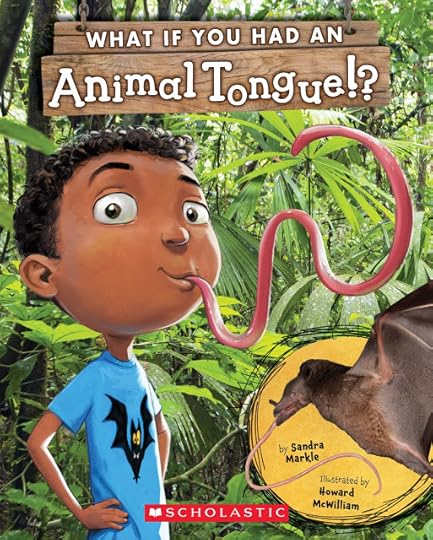
SPIDER FUN!Can You Solve The Mysteries?The sp...
SPIDER FUN!

Can You Solve The Mysteries?
The spiders below have been divided into 2 groups--those that alike and those that are different. What makes the spiders in Group 1 alike? What makes them different from Group 2?
 Group 1
Group 1
 Group 1
Group 1 Group 2
Group 2
 Group 2
Group 2
Did you guess that the spiders in Group 1 share having two middle front eyes that are bigger than their other eyes?
Now brainstorm at least three other features you could use to regroup the spiders into groups: those that share the feature and those that don't.
Here are two possibilities to get your creative juices flowing:
Group 1: Those that are light colored; Group 2: Those that aren't. Group 1: Those that look hairy; Group 2: Those that don't.
Can you do this!?
Eat Like A Tarantula

Some spiders, like tarantulas, are able to crush and partly break up the prey they catch. However even the biggest tarantulas can't chew and swallow chunks of food. They bring up digestive juices that break down their food into a gooey liquid. Then suck it in.
To sample eating like a tarantula work with an adult partner and follow these steps:
1. Start with one ready-to-eat mini-cup of fruit-flavored Jell-O.

2. Scoop the Jell-O into a cup. Mash it with a spoon or fork. Now, it's broken up like a tarantula's buggy meal.
3. Pour in apple juice to cover the Jell-O. The apple juice will act like digestive juice the tarantula brings up.
4. When the Jell-O is a gooey liquid, use a straw to drink it up.
The tarantula in the picture is a female pinkfoot goliath. It's as big as a dinner plate! So, it's big enough to eat this small snake. You may be surprised to know spiders don't taste with their mouths. They taste with the hairs on their feet!
Check out animals that taste and more with their tongues in my newest book! Pick your favorite. Mine is on pages 22-23.

October 30, 2020
YOU'VE GOT THIS!
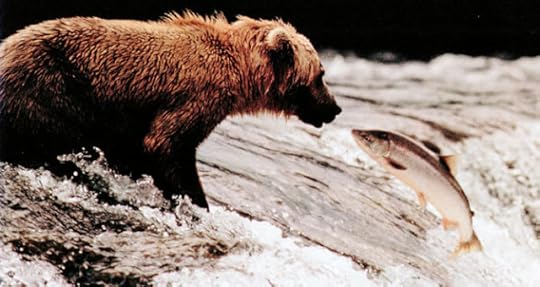
There's nothing more fun than figuring out..."What will happen next?"
This is a great STEM challenge and brain tickler because it isn't always what looks likely at first glance.
First, look for clues, including ones that are not obvious at first glance.
1. What will the bear need to do to catch the fish?2. What will the fish need to do to escape?3. Which is likely to be faster--BEAR? FISH?

YOU'VE GOT THIS!Actually, the bear got this!
 So how's your reaction time? YOU'VE GOT THIS!
So how's your reaction time? YOU'VE GOT THIS! To test it, have a partner hold a ruler at the top with zero end down.
To test it, have a partner hold a ruler at the top with zero end down.Hold onto the ruler so your thumb is close to the zero.
Next, open your grip so your fingers are no longer touching the ruler and stay alert.
Your partner will suddenly release the ruler.
Grab it.
Then look to see which number is under your thumb. The lower the number, the faster you were able to react.
Repeat this test two more time.
Does your reaction time improve with practice? Switch and test your partner's reaction time.
ONE MORE CHALLENGE
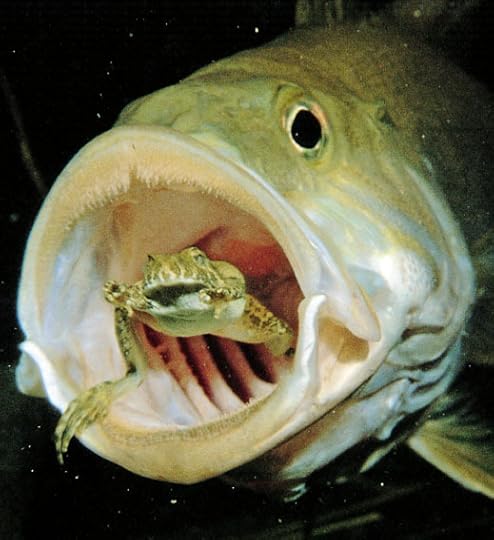
Will the fish be able to gulp in the frog? Or is a frog quick enough in the water to be likely to escape? Imagine yourself in the frog's place. What would your next move be? Imagine yourself in the fish's place. What would your next move be?YOU'VE GOT THIS!Predict what's most likely to happen next. Tell why you made that choice.
ARE YOU MISSING OUT?
To ALL Teachers, Librarians, and Media Specialist...
ARE YOU A MARKLE'S BOOK EXPLORER?
It's the way to receive personalized, monthly emails from me with fun facts and FREE, ready-to-go, activities. These are all what I call STREAM activities with the "R" for reading.
Just email sandramarkle@yahoo.com and share Your name, School Name and Address, and email address.
DON'T MISS OUT ANY LONGER
Sign up now!

